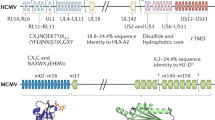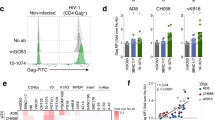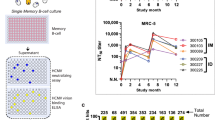Abstract
RECENT experiments have indicated that the cytolysis of virus-infected, chemically modified, or neoplastic cells by murine T lymphocytes is restricted to target cells carrying one or more of the H–2 antigens possessed by the cells against which the cytotoxic T cells were generated1–10. Two general hypotheses have been proposed to explain the participation of H–2 antigens in T–cell-mediated cytolysis. According to one hypothesis, T lymphocytes possess two different types of receptors, one which recognises the abnormal antigens of the target cell, and a second which interacts with the H–2 antigens of that cell. In the alternative hypothesis, the T cell has only one specific receptor that is directed against a complex antigenic determinant made of of H–2 antigens and viral antigens, for example, tumour antigens induced by viral infection. Neither of these hypotheses has yet been satisfactorily proven. In support of the one-receptor hypothesis, we have found that anti-H–2 and antiviral sera show copatching and cocapping of H–2 and viral antigens on the surface of EL4 leukaemia cells9, suggesting that viral and H–2 antigenic determinants can be in close physical association on the cell surface. Here we provide new evidence for the existence of a close association between H–2 antigens and viral antigens on murine leukaemia cells.
This is a preview of subscription content, access via your institution
Access options
Subscribe to this journal
Receive 51 print issues and online access
$199.00 per year
only $3.90 per issue
Buy this article
- Purchase on Springer Link
- Instant access to full article PDF
Prices may be subject to local taxes which are calculated during checkout
Similar content being viewed by others
References
Doherty, P. C., Blanden, R. V., and Zinkernagel, R. M., Transplant. Rev., 29, 89–124 (1976).
Schrader, J. W., Henning, R., Milner, R. J., and Edelman, G. M., in XLI Cold Spring Harb. Symp. quant. Biol. (in the press).
Shearer, G. M., Rehn, T. G., and Garbarino, C. A., J. exp. Med., 141, 1348–1346 (1975).
Gomard, E., Duprez, V., Henin, Y., and Levy, J. P., Nature, 260, 707–709 (1976).
Pfizenmaier, K., Starzinksi-Powitz, A., Rodt, H., Röllinghoff, M., and Wagner, H., J. exp. Med., 143, 999–1004 (1976).
Zinkernagel, R. M., Nature, 261, 139–141 (1976).
v. Boehmer, H., and Haas, W., Nature, 261, 141–142 (1976).
Germain, R. N., Dorf, M. E., and Benecerref, B., J. exp. Med., 142, 1023–1028 (1975).
Schrader, J. W., Cunningham, B. A., and Edelman, G. M., Proc. natn. Acad. Sci. U.S.A., 72, 5066–5070 (1975).
Schrader, J. W., and Edelman, G. M., J. exp. Med., 143, 601–614 (1976).
Bernoco, D., Cullen, S., Scudeller, G., Trinchieri, G., and Ceppellini, R., in Histocompatibility Testing (edit. by Dausset, J., and Colombani, J.), 527–537 (Munksgaard, Copenhagen, 1973).
Hauptfeld, V., Hauptfeld, M., and Klein, J., J. exp. Med., 141, 1047–1056 (1975).
Milner, R. J., Henning, R., and Edelman, G. M., Eur. J. Immun. (in the press).
Klein, P. A., J. Immun., 115, 1254–1260 (1975).
Nowinski, R. C., and Klein, P. A., J. Immun., 115, 1261–1268 (1975).
Blanden, R. V., Hapel, A. J., and Jackson, D. C., Immunocheinistry, 13, 179–191 (1976).
Bevan, M. J., Nature, 256, 419–421 (1975).
Gordon, R. D., Simpson, E., and Samelson, L. E., J. exp. Med., 142, 1108–1120 (1975).
Henning, R., Milner, R. J., Reske, K., Cunningham, B. A., and Edelman, G. M., Proc. natn. Acad. Sci. U.S.A., 73, 188–122 (1976).
Boyum, A., Scand. J. clin. lab. Invest., 21, 1–109 (1968).
Mãrchalonis, J. J., and Cone, R. E., Santer, V., Biochem. J., 124, 921–927 (1971).
Author information
Authors and Affiliations
Rights and permissions
About this article
Cite this article
HENNING, R., SCHRADER, J. & EDELMAN, G. Antiviral antibodies inhibit the lysis of tumour cells by anti-H–2 sera. Nature 263, 689–691 (1976). https://doi.org/10.1038/263689a0
Received:
Accepted:
Published:
Issue Date:
DOI: https://doi.org/10.1038/263689a0
This article is cited by
-
Serological characterization of previously unknown H-2 molecules identified in the products of theK d andD k region
Immunogenetics (1981)
-
Independence of H-2 and viral antigens on the cell surface and absence of H-2 antigens on murine leukemia virus and mouse mammary tumor virus particles
Immunogenetics (1981)
-
H–2 Antigens on a murine lymphoma are associated with additional proteins
Nature (1978)
Comments
By submitting a comment you agree to abide by our Terms and Community Guidelines. If you find something abusive or that does not comply with our terms or guidelines please flag it as inappropriate.



